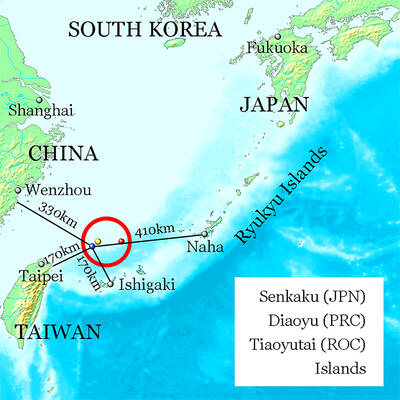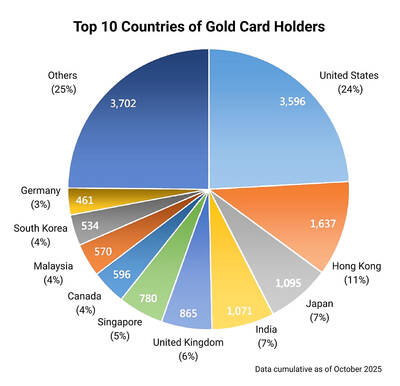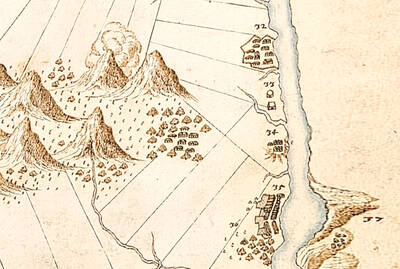The National Museum of History has recently mounted several notable exhibitions on China’s history. The Smiling Kingdom: The Terra-Cotta Warriors of Han Yang Ling (微笑彩俑—漢景帝的地下王國), for example, provided an in-depth look at societal changes through funerary objects excavated from the mausoleum of an early Han Dynasty emperor.
But there have been misses, too. A Drop in the Ocean: Modern Contemporary Chinese Calligraphy and Painting Exhibition (滄海一粟—近現代書畫展) threw up hundreds of calligraphic scrolls and ink paintings without adequately explaining the exhibits’ context.
Legends of Heroes: The Heritage of the Three Kingdoms Era (英雄再起─大三國特展), a new exhibition on the museum’s first floor, is of the latter category.
“By presenting the era from different angles and on different levels, and by adopting wide-ranging approaches, it should be possible to present a comprehensive picture of military affairs, technology, economy, daily life, art [and] religion ... in the Three Kingdom era, as well as the influence that the history of the Three Kingdoms has exerted on later generations,” the show catalog says.
What we get, however, is a romantic glimpse of the period that lacks historical rigor. Aside from focusing on the era’s heroes, the exhibition only superficially links the age’s rulers and the societies they dominated.
The museum borrowed 146 artifacts from 32 museums in China, including sculptures, seals, calligraphy, ceramics and gold and silver jewelry excavated from 70 historical sites dating back to the kingdoms of Wei (魏), Shu (蜀) and Wu (吳).
Legends of Heroes focuses on three broadly chronological themes: official histories of the era; the period as depicted in the Ming Dynasty novel Romance of the Three Kingdoms (三國演義); and later representations of the era’s heroes, whether found in the hand scrolls and wood carvings of the Ming Dynasty or contemporary animation and computer games.
The museum uses the Qing Dynasty Albums of Emperors and Famous Officials to present the stories of the Three Kingdom’s movers and shakers, including the tyrannical though highly organized Wu kingdom founder Cao Cao (曹操) and brave Shu general Guan Yu (關羽).
But the connection between the historical figures and the objects on display is never made explicit, with visitors left to fill in the blanks. The exception is the section on Zhuge Liang (諸葛亮, also known as Kong Ming (孔明), which illustrates the relationship between his curious
personality and the inventions that appeared during his reign.
What a shooting and hunting scene or a celadon pot in the shape of a frog has to do with Zhao Yun’s (趙雲) bravery or Zhang Fei’s (張飛) courage is anybody’s guess.
One of the highlights is the Romance of the Three Kingdoms section that includes scrolls depicting the Battle of the Red Cliff, which provide valuable insights into how different artists from various points in time viewed that period.
The contemporary display items, however, are barely worthy of a museum. One room houses four monitors that show computer games based on the Three Kingdoms, while another room houses an interactive display of cartoon characters of Kong Ming and Guan Yu.
“How cute!” exclaimed a young viewer.
The flashy and forgettable use of technology is made even more disappointing because interactive media have been used to great effect in Huaxia Artifacts (館藏華夏文物展), an ongoing exhibition of ancient Chinese artifacts on the museum’s third floor.
Too many of the objects on display are only tangentially related to the overall theme of heroism and its subsequent depictions in art and popular culture. Limiting the objects to the exhibition’s theme would have created a more coherent and less frustrating experience.

Last week gave us the droll little comedy of People’s Republic of China’s (PRC) consul general in Osaka posting a threat on X in response to Japanese Prime Minister Sanae Takaichi saying to the Diet that a Chinese attack on Taiwan may be an “existential threat” to Japan. That would allow Japanese Self Defence Forces to respond militarily. The PRC representative then said that if a “filthy neck sticks itself in uninvited, we will cut it off without a moment’s hesitation. Are you prepared for that?” This was widely, and probably deliberately, construed as a threat to behead Takaichi, though it

Seven hundred job applications. One interview. Marco Mascaro arrived in Taiwan last year with a PhD in engineering physics and years of experience at a European research center. He thought his Gold Card would guarantee him a foothold in Taiwan’s job market. “It’s marketed as if Taiwan really needs you,” the 33-year-old Italian says. “The reality is that companies here don’t really need us.” The Employment Gold Card was designed to fix Taiwan’s labor shortage by offering foreign professionals a combined resident visa and open work permit valid for three years. But for many, like Mascaro, the welcome mat ends at the door. A

Nov. 17 to Nov. 23 When Kanori Ino surveyed Taipei’s Indigenous settlements in 1896, he found a culture that was fading. Although there was still a “clear line of distinction” between the Ketagalan people and the neighboring Han settlers that had been arriving over the previous 200 years, the former had largely adopted the customs and language of the latter. “Fortunately, some elders still remember their past customs and language. But if we do not hurry and record them now, future researchers will have nothing left but to weep amid the ruins of Indigenous settlements,” he wrote in the Journal of

If China attacks, will Taiwanese be willing to fight? Analysts of certain types obsess over questions like this, especially military analysts and those with an ax to grind as to whether Taiwan is worth defending, or should be cut loose to appease Beijing. Fellow columnist Michael Turton in “Notes from Central Taiwan: Willing to fight for the homeland” (Nov. 6, page 12) provides a superb analysis of this topic, how it is used and manipulated to political ends and what the underlying data shows. The problem is that most analysis is centered around polling data, which as Turton observes, “many of these